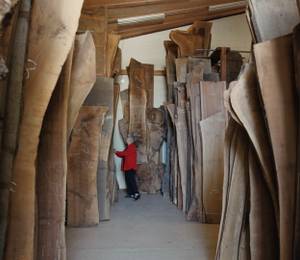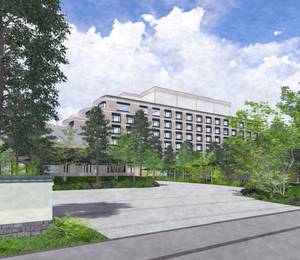London, UK – Haptic Architects and PIR2 have won a competition to design a new school and cultural centre for the Bærum municipality, creating a bold new landmark building on the site of Oslo’s decommissioned airport, for an emerging neighbourhood in Fornebu. The competition attracted 29 prequalification submissions from interdisciplinary teams, and the winning team’s proposal was selected from a five-strong shortlist that included Bjarke Ingels Group (BIG) and NORD Architects.
With the plans still to be finalised, the Tårnkvartalet proposal will co-locate a secondary school for over 900-students with wider community amenities including a cultural centre, black box theatre, sports centre, library, health clinic, and skate park, alongside workshops and cafés, in a 16,000 square metres civic hub.
The unique stepped brick and timber building is set to create a socially and environmentally sustainable cultural centre for the Fornebu district, a peninsular area just outside central Oslo. The proposal will be the heart of the area’s wider masterplan, which has been under development for over two decades, since the airport was decommissioned, and has a population set to grow to 25,000.
Tårnkvartalet – meaning the tower quarter – responds to the cultural heritage of the historic transport aviation site, Norway’s first ever airport, and the original structures that remain, including the former air traffic control tower. The large-scale scheme has a clear identity as a standalone civic building, while also working as a continuation of the large-span 1940s airport hangars, which have been repurposed during the redevelopment to house creative workshops, artist studios and TV production facilities.
The scheme will have a voluminous amphitheater at its centre, facing onto a new civic square, via a large ‘hangar door’ opening. The central atrium will have an inner ‘street’ running over it, and give way to a series of spacious open-plan volumes around it, housing the centre’s dynamic programme of public facing amenities, creating a fully activated and welcoming ground level. Framed by a distinct envelope built from locally recycled red brick, these ground floor spaces will all lead onto carefully curated surrounding landscapes, ranging from an urban plaza to a sheltered park area, and wide-open green space.
Above the brick base layer will sit a series of stepped, lighter timber framed structures, housing a world-class learning environment, featuring interconnected classrooms and teaching areas, each leading directly onto sheltered outdoor space, with raised views over the peninsula. The upper levels will have glazed façades, designed to reflect the lantern of the adjacent air traffic control tower, while creating a sense of transparency and openness for the students, aged 13 to 16-years-old.
The building, which is to be composed largely from re-used materials and sustainably sourced timber, can be reconfigured over time to reflect the community as it grows and evolves. Designed to meet Norway’s FutureBuilt criteria, the scheme aims to set new environmental standards in school design.
On the competition win Scott Doig, Design Director of Haptic Oslo, commented: “This piece of city regeneration represents a bold and progressive investment in education and culture to spearhead the placemaking process. We have enjoyed responding to this aspirational brief, and the unique historical heritage of the site.”
Philip Stensrud, Design Director of PIR2 Oslo, added: “We have tried to keep Tårnkvartalet human scale, and sympathetic to its unique surroundings, while at the same time offering an architectural centrepiece, and civic focal point, for this exciting new neighbourhood district. Co-locating the school and cultural facilities has given way to a new and dynamic scheme, using a mix of materials, architectural forms and spaces, and indoor and outdoor settings.”
A spokesperson from the jury noted: “We selected Haptic and PIR2’s proposal as it provided a clear urban plan approach that we believe will help to create a new creative centre for the neighbourhood. The winning team succeeded in designing a building that will have a strong identiy, while harmonising with the existing buildings on the site. The building has a fully active facade, and the inner street and central hall provide a exciting initial spatial experience. We look forward to seeing the design develop.”
The development is expected to open to the public and students in August 2027.

















